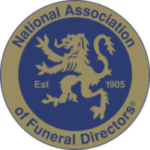Registering a death
Registration procedures vary slightly in each registration district. The main elements involved in registering a death are normally as follows:
The registration is normally completed by a relative of the deceased. If no relative is available then that duty may be performed by any person present at the death, the occupier of the premises where the death took place, or the person who is accepting responsibility for arranging the funeral, such as an executor.
In most cases the death should be registered within five days of the death, or in the event that the Coroner’s office is involved, as soon as possible after the Cause of Death is issued. This process can be completed in one of two ways.
- Booking an appointment at the Register Office in the district that the death occurred. Attendance at this office will ensure no unnecessary delays to the funeral as all the required certificates will be issued by the registrar at the time of registration.
- Booking an appointment at any other Register Office in England and Wales. If this way is easier we will advise you on the procedure but please note that there will be a delay when booking the funeral date and time. The registration documents we require for the funeral have to be posted to and from the registrars concerned. Before the funeral can take place.
The registrar will require the following documents:
- The medical Cause of Death Certificate (issued by the usual doctor or hospital doctor.) This form is not issued when the Coroner has ordered a post-mortem. In such cases the coroner will normally send a Certificate directly to the registrars concerned after the cause of death has been ascertained. Where possible (but not essential)
- The informants. Passport or photo driving license and proof of residency (council tax or utility bill)
- The deceased’s Passport, Birth Certificate, Marriage certificate or civil partnership certificate, Proof of residency (council tax or utility bill), Medical card, Blue badge (if issued by local borough council)
Registering following a Coroner's inquest
This is the only time that the death is not registered by the family. The Coroner will register the death when the inquest has been closed (often some months after the funeral.) On request the coroner may be able to issue “Interim Death Certificates” for the period of time between the death and the death being registered.
- Information required registering the death and making funeral arrangements
- The date and place of the death
- The full name of the deceased
- The date and town of their birth
- Their occupation up until retirement
- Their home address
Additional details required by the registrar (if applicable):
- Their maiden name
- Their spouse’s/late spouse’s full name
- Their spouse’s/late spouse’s occupation
- Their surviving spouse’s date of birth
- Additional details required by the funeral director: their usual doctor’s name and surgery address
Forms the registrar will issue:
- Certificate for burial or cremation (the green form) which needs to be handed to the funeral director at least two working days prior to the funeral (if the Coroner is involved this is not always issued)
- Certificate of Registration BD8 (white form) to be filled in and posted in the envelope provided to adjust the Social Security pension
- Certified copies of the registrar’s entry (original death certificates). A statutory fee is payable for these.







